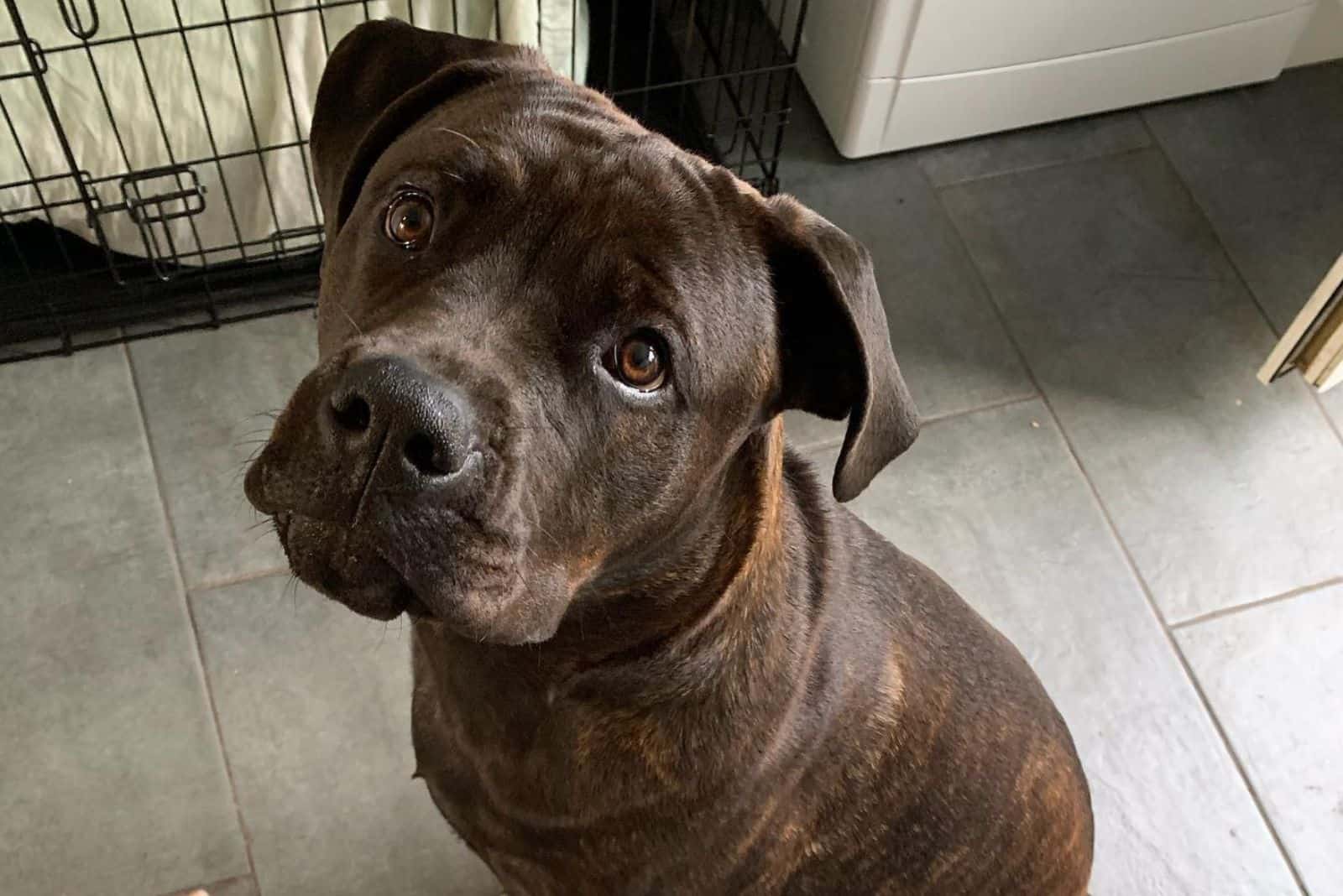Despite the fact that the Rottweiler Bullmastiff mix is one of the most popular Rottweiler mixes, there is still a debate on whether these dogs make good companions as well. In order to get to know this giant properly, we need to look into its ancestry.
Both Rottweilers and Bullmastiffs are excellent protectors of their family, but at the same time, they make loyal and affectionate pets that won’t display aggression unless they are challenged.
Their offspring, the Bull Mastweiler, happens to be the same. However, this puppy has a long way to go before we can perceive it as a true family dog.
What Is The Rottweiler Bullmastiff Mix?
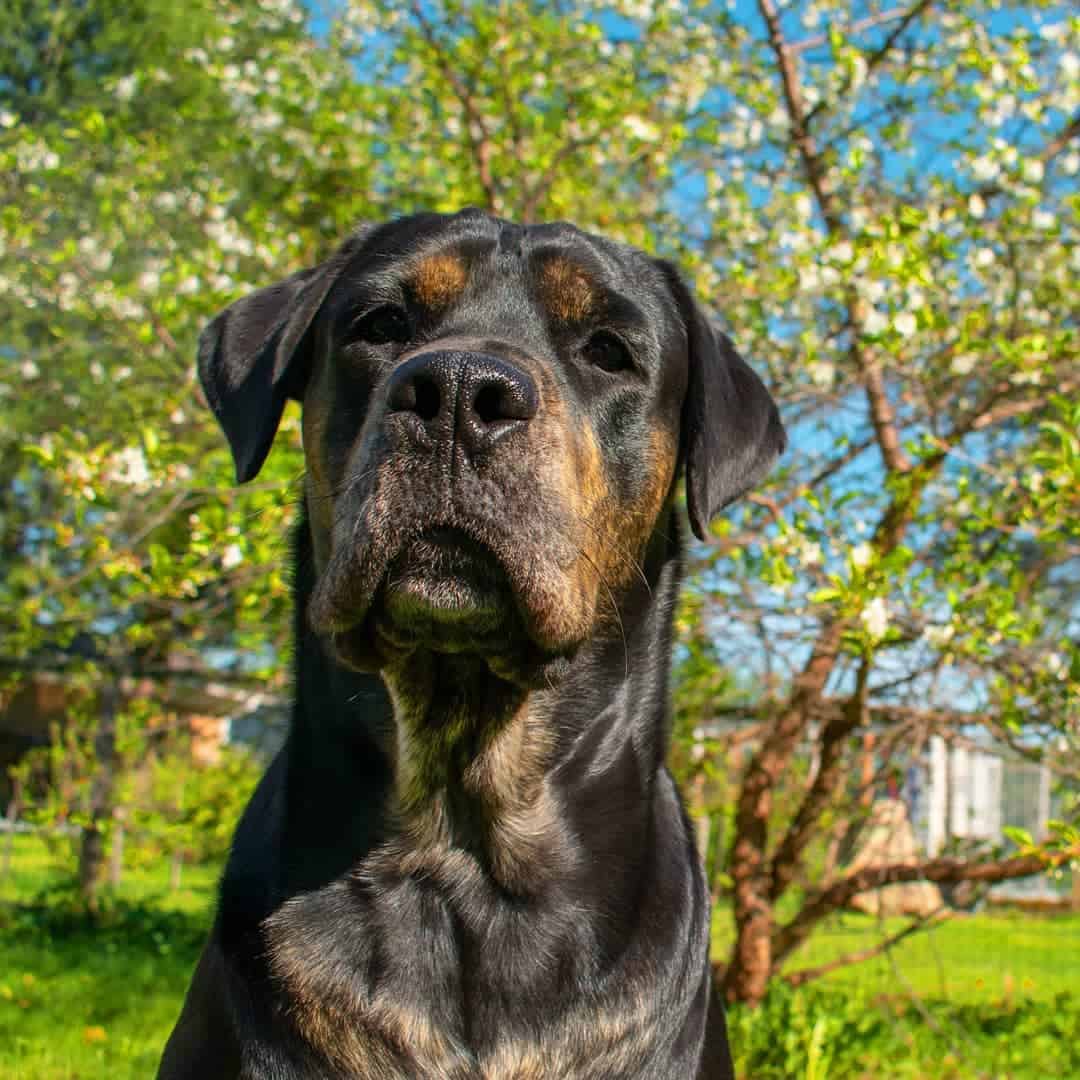
Unlike original Mastweilers that happen to be a cross between Rotties and English Mastiffs, the Bull Mastweiler is a much smaller dog that stands between 23 and 25 inches in height, and 90 to 130 pounds in weight, which goes along the growth chart of Bullmastiff puppies.
Still, this is a large puppy that requires plenty of space.
Placing one of these hybrid dogs inside a small apartment is probably not a good idea as bored Bull Mastweilers can chew, dig, and rip furniture as a sign of protest. The dog is rather recommended to families with a big back yard and a spacious home.
Even though the canine doesn’t qualify among purebred dogs, Bull Mastweiler puppies are excellent guard dogs with high intelligence levels.
Some people may be prejudicial about this crossbreed as it looks intimidating and scary at first, but the truth is that Bullmastiff Rottweiler mixes are, indeed, wonderful companions.
The puppy needs socialization and early training, after which it displays a calm, confident, and affective temperament towards its owner.
Still, these canines are recommended for more experienced owners and families with adults as puppies need a certain amount of supervision during playtime with children.
Meet The Parent Breeds
Generally, the best way to meet a crossbreed is if we dig into its parent breeds first. In order to get to know this gentle giant, we need to know where it comes from.
The puppy is a proud offspring of the Rottweiler and the Bullmastiff – two wonderful guardians, both having over a hundred-year-long tradition in the American Kennel Club.
There are a plethora of Rottie breeders that sell this puppy with the label of true protector and companion, which is the case with their Bullmastiff counterparts, too.
However, all reputable breeders emphasize the fact that these puppies are high maintenance as they need constant supervision and firm leadership.
These giants generally respond well to early mental stimulation, which is why they need to be worked with from the early puppyhood stage. Well-socialized Rotties and Bullmastiffs show no sign of stubbornness, and they are eager to please.
Unfortunately, that’s not the case with improperly-raised puppies as they rather prefer being independent and having their own way.
Rottweiler
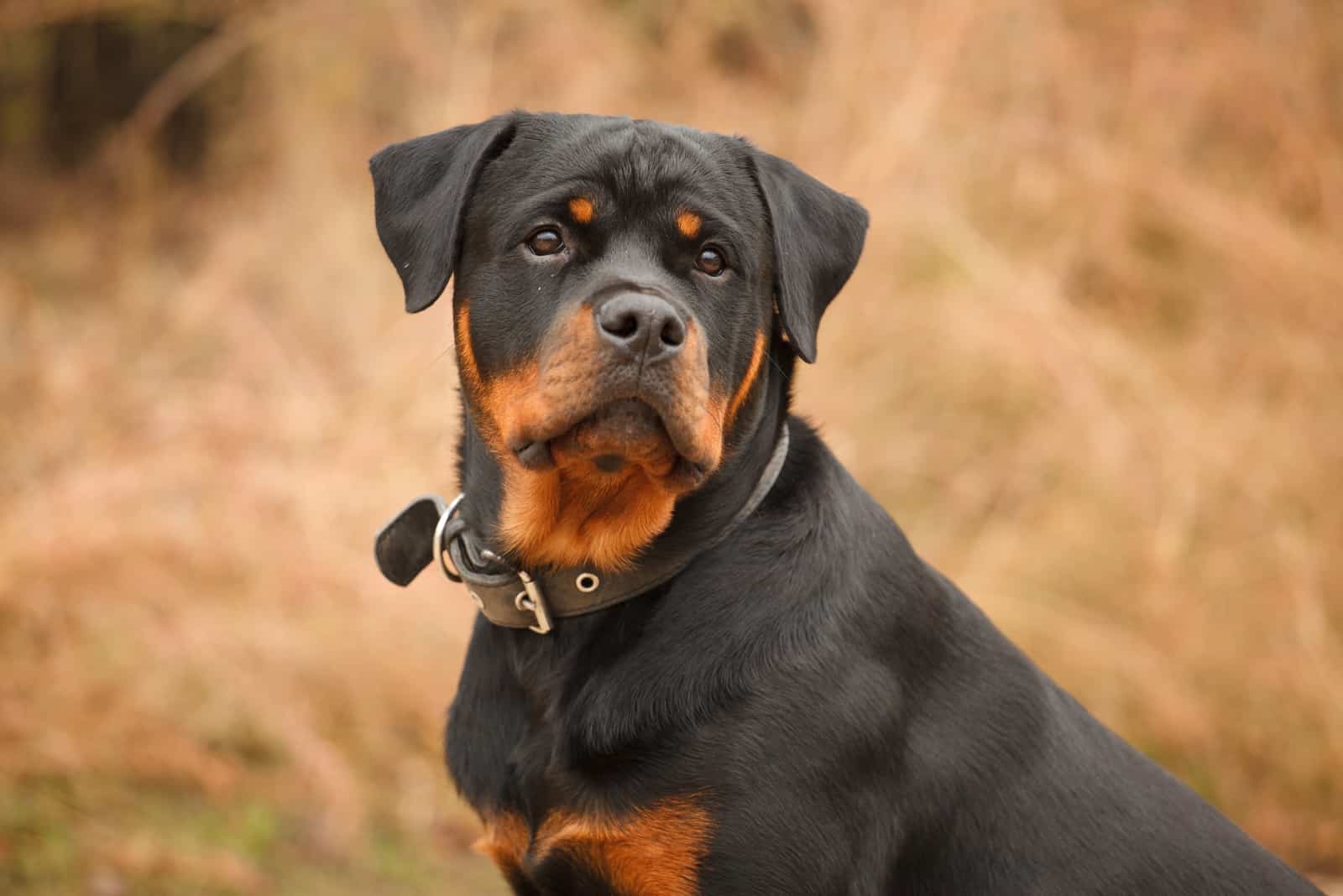
This large dog breed dates back to Roman times, when it served as a cattle dog. With that being said, Rotties are probably one of the oldest breeds in the world.
Their exquisite muscle strength has been used in German households and farms for years as this puppy was a respectable working dog and quite a popular dog breed in herding and livestock protection.
During WWII, the puppy was used as a messenger, a guardian, and a rescue dog due to its high intelligence.
Nowadays, these canines make decent family pets all over the world. Still, they have retained their sharp look and muscular body physique. That’s why to this day, Rottie puppies need a lot of exercise during the day (at least 60 minutes a day), including long walks and hikes.
Many Rottie enthusiasts wonder if these canines are good with kids, and the truth is – yes! In fact, the breed is extremely tolerant of small kids, which is why they are favorable to have in all types of families.
However, make sure you socialize your puppy from puppyhood as improperly-trained Rotties have a tendency of playing roughly.
The breed generally stands up to 27 inches in height, and an average Rottie weighs between 95 and 135 pounds. Due to their large size, they require special attention when it comes to their feeding chart as standard kibble and wet food cannot satisfy their daily needs.
They need a lot of protein intake in order to preserve their muscles and stamina. Unlike a Mastiff, these canines are pretty agile as they have muscular hindquarters. Together with German Shepherds, they make excellent K-9 police dogs.
Bullmastiff
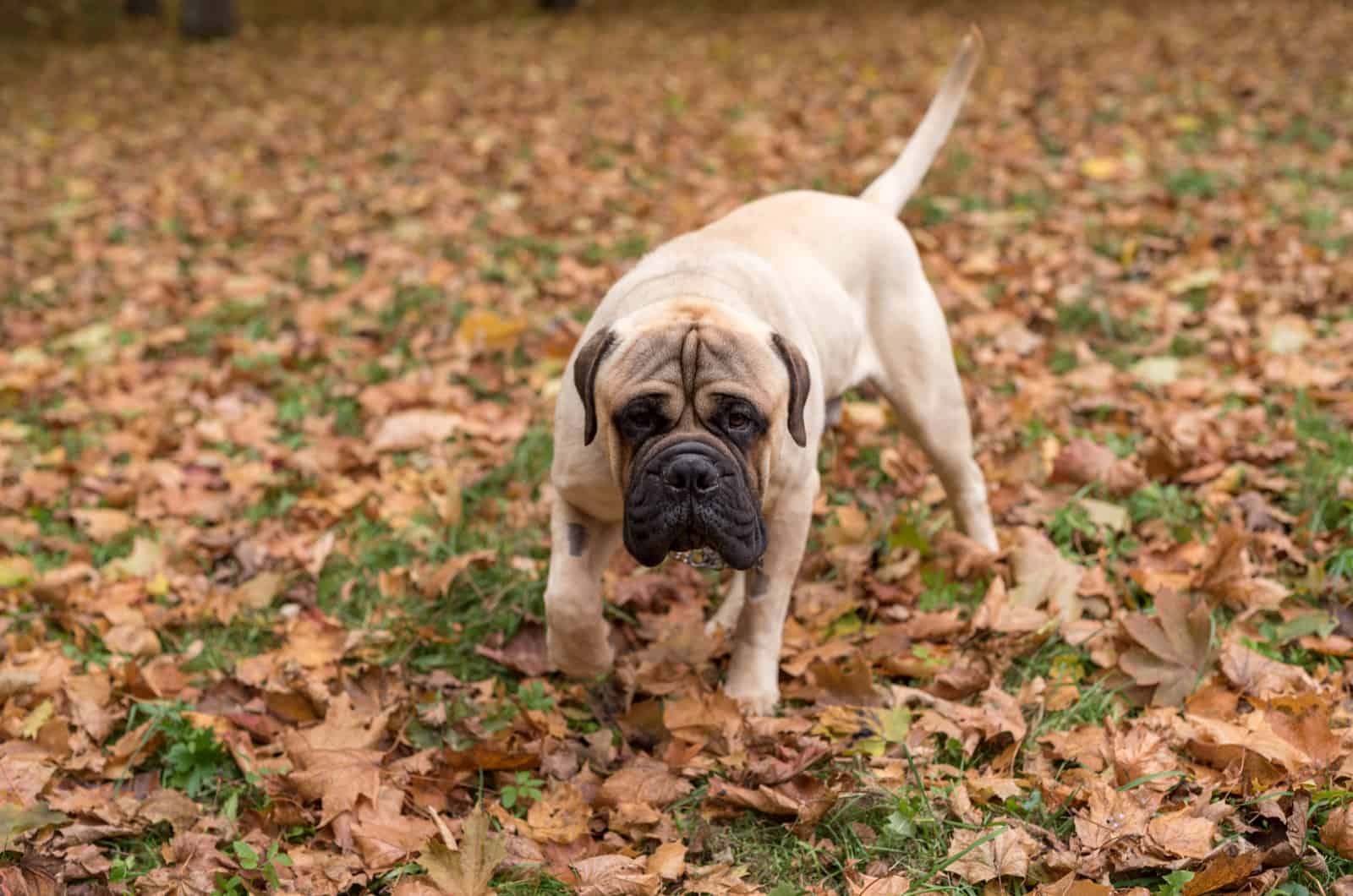
Standard Bullmastiff puppies are much smaller than their English Mastiff counterparts as they weigh 110 to 130 pounds on average, and their height reaches up to 27 inches.
These AKC-recognized, giant dogs are loyal, independent, and brave, which makes them excellent guardians of families. They were originally bred by gamekeepers in England.
Due to their high intelligence, these canines are well-known contestants in agility, carting, and obedience.
Adult canines may display stubbornness at times, which is why you need to start implementing socialization training from day one.
This dog is affectionate towards family members, but it may be aloof with strangers. Generally, Bullmastiff puppies are calm, confident, and well-behaved at all ages.
Just like their Rottie buddies, Bullmastiff dogs need a well-planned feeding chart and timely feeding. Even though the breed is far lighter than their cousins from England – English Bulldogs, the puppy still needs a proper amount of protein in order to maintain its muscular physique.
The Bullmastiff canine rather uses its powerful physique and a vigilant standing point to intimidate poachers and predators instead of barking and chasing them around.
Even though this behavior is enough to scare them away most of the time, the puppy is not reluctant when it comes to fighting.
These canines will do anything to protect and serve their owner, which is why this giant dog breed places at the top of the list of the best protection dogs in the world.
A Little Walk Through The Rottweiler Bullmastiff Mix’s History
Despite the fact that their exact birth date is vague, these Bullmastiff Rottweiler mix puppies have been among U.S. families for quite some time. The idea behind crossbreeding a Rottie with a Bullmastiff was to design a strong, confident protector with exquisite family traits.
To this day, these puppies are affectionate, loyal, and good with children as they are giant children themselves. However, their childish behavior doesn’t stand in the way of behaving properly as these canines are reasonably mannered.
All Rottweiler mixes have a high sense of affection towards their owner, which is what makes this crossbreed even better.
Generally, it is quite difficult to dig into the history of a crossbreed as these canines are pretty hard to trace down. Still, if we look into the history of both the Rottie and the Bullmastiff, we will see that this particular hybrid has a lot to offer.
Outstanding protection skills of the Rottie, and the beautiful, confident nature of the Bullmastiff give these puppies the reason to be called one of the best watchdogs on the market of hybrids!
Physical Appearance Of The Bull Mastweiler
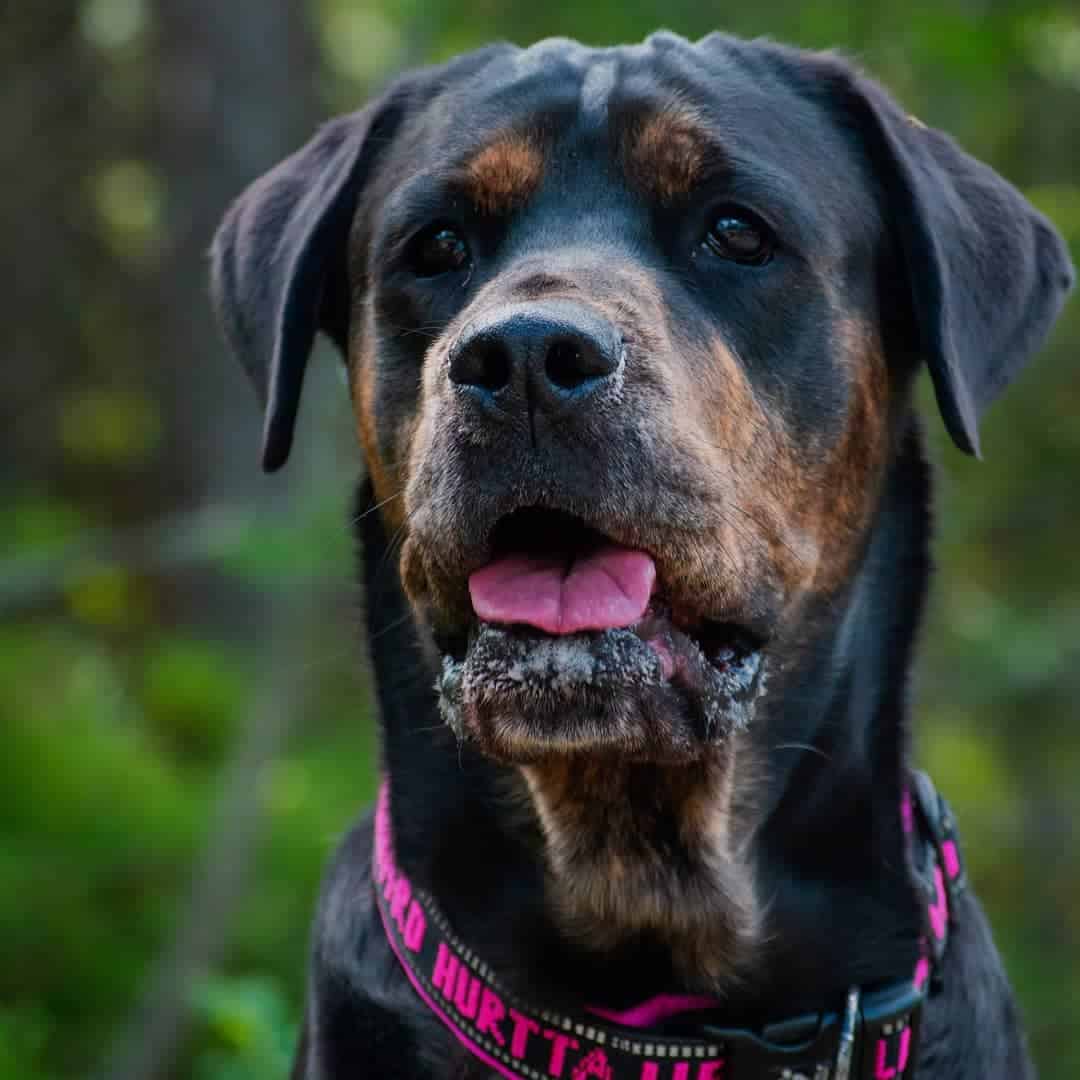
Unlike Rottweiler X Mastiffs, these gentle giants are slightly smaller as they reach up to 135 pounds in weight. Still, they appear as intimidating, sharp-looking, and vigilant giants at all times.
However, their look doesn’t quite tell the story as these canines are extremely affectionate and playful.
They typically inherit the big, flat head of a Rottie puppy, together with the thick, short, and wrinkled muzzle of a Bullmastiff. Their body is muscular and strong by default, which doesn’t cover the fact that their hindquarters are athletic and quite impressive.
These canines need moderate exercise during the day as they are not as active as Dobermanns or GSDs. Still, you should never skip a training routine as bored and frustrated Bull Mastweilers are not good news.
These mixed breed dogs have a smooth, short coat that sheds moderately. Still, you will need to brush them on a weekly basis in order to maintain a neat, shiny look. The puppy inherits both the Bullmastiff’s and the Rottie’s colors, but it doesn’t have a uniform appearance.
Size
The Bull Rottweiler breed stands up to 27 inches in height, and it can weigh anywhere between 90 and 135 pounds.
This is a pretty big dog, which means that you need to take care of its daily eating habits properly. The breed doesn’t get enough protein from standard kibble or wet food.
They rather enjoy a well-prepared, raw diet which contains sufficient macronutrients. Always avoid poor dog food brands and table scraps as these canines are prone to cardiomyopathy from their Rottie parents’ side.
Keeping your puppy’s feeding chart strict and to the point will help you prevent additional health problems, such as bloat and hip and elbow dysplasia.
Giving them four to six cups of food a day, divided into three meals during their puppyhood stage, and two meals during adulthood, is the perfect measure.
Coat Type And Coat Color
The Rottweiler Bullmastiff mix, just like its parent breeds, has a smooth, short coat, but puppies that lean towards their Rottie parents tend to also have a thick undercoat.
They are moderate shedders, which means that you will need to brush your puppy at least once a week. Regular brushing preserves a shiny look, and it resolves many skin problems, such as dander and allergies.
If you take your puppy out on a regular basis, make sure you give it a bath every two months or so. As this is an active breed, puppies tend to get dirty during playtime, which is why they need proper maintenance.
Before using a dog shampoo for your puppy, make sure your dog doesn’t suffer from any allergies. An allergy checkup will prevent unpleasant symptoms, such as skin redness, eye irritation, sneezing, and tears.
When it comes to coat colors, these canines come both in Rottie and Bullmastiff color patterns. This means that you can find this canine in red, red brindle, fawn, fawn brindle, black and rust, black and mahogany, and black and tan coat colors.
The dog has a pretty fashionable look, considering its great coat color potential. Still, in order to have a true fashionista, you need to give your puppy proper grooming and good care.
Temperament Of A Rottweiler Bullmastiff Mix
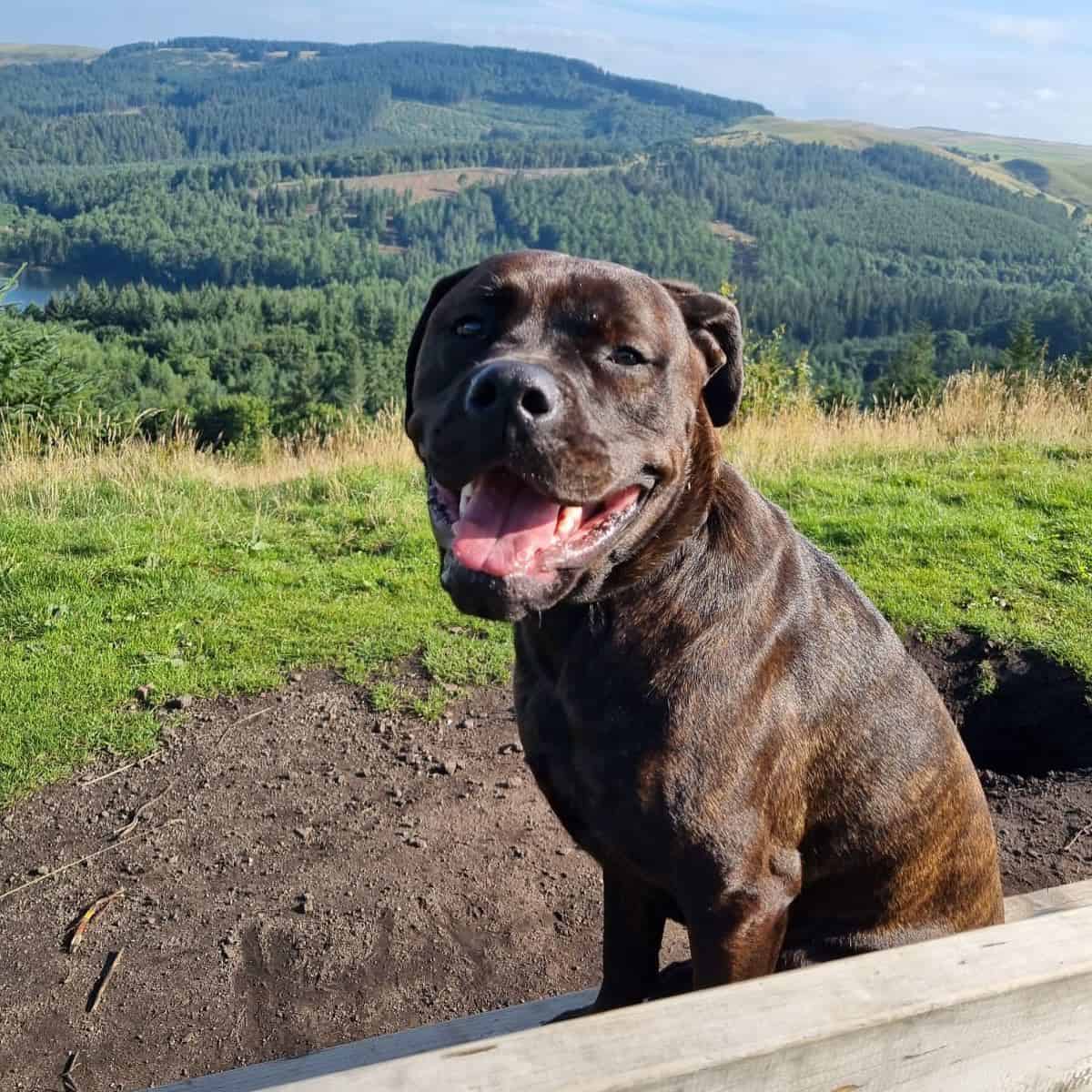
The Rottweiler Bullmastiff mix comes from two extremely affectionate pure breeds. In fact, the Bullmastiff puppy is known to be among the best Mastiff breeds that make wonderful family dogs, too.
Due to this quality, Bull Mastweiler puppies are highly favorable among all types of dog lovers, even the inexperienced ones.
Still, if you want your Bull Mastweiler to be well-behaved and mannered, you need to train it in obedience and socialization from its puppyhood stage. Luckily, these canines respond reasonably well to positive reinforcement techniques, such as snacks, praise, and petting.
Still, the dog needs firm leadership in order to realize who the pack leader is. That’s why these canines are not exactly recommended for novice owners.
However, if you are inclined to buy this powerful hybrid, but you don’t have enough experience to raise the puppy properly – make sure you consult a professional dog trainer.
Additionally, the puppy’s daily exercise requirements need to be fulfilled. The breed is highly intelligent, which means they need constant stimulation and a creative approach.
You don’t want to have a bored puppy in your home as bored Bull Mastweilers display self-destructive behavior on occasion.
Are Rottweiler Bullmastiff Mixes Aggressive
Despite the fact that these puppies are well-mannered by default, they still come from two naturally aggressive dog breeds. With that being said, your dog will need a lot of obedience training and socialization.
The best way to start implementing socialization techniques is if you start during the first couple of weeks. Small puppies need to learn how to behave in groups as well as around every stranger who does not necessarily represent a danger to your home.
There are several situations in which a Rottweiler Bullmastiff mix will display aggression. First, the aggression is related to improperly-raised Bull Mastweilers. Teaching your dog how to bite or chase after cats is never a good idea.
Furthermore, a dog that doesn’t receive the proper amount of exercise during the day may be self-destructive and aggressive, even to owners. These canines have a high energy level, which requires daily energy burnout.
Lastly, the puppy might display undesirable behavior in a state of anxiety. Particularly, despite their independent and calm nature, this breed doesn’t stand solitude.
If you’re thinking about getting one of these puppies for yourself, make sure you have a flexible schedule. Otherwise, you may want to consider a different dog breed.
Socialization And Housing
Typically, it is much easier to handle a small dog in your house as small dogs don’t require much space and movement. However, this gentle giant is far from misbehaving indoors as they easily adapt and learn good manners once you get them in a house.
Namely, these canines are great additions to a family, both indoors and outdoors, as they enjoy spending time with their owner. They will gladly accompany you on walks and road trips, but at the same time, the breed enjoys curling up next to its owner and watching some TV.
That’s right – these pooches are decent family members, especially if you give them the proper amount of obedience training. Early socialization and obedience training are two of the most important segments for having a well-mannered Bull Mastweiler.
Their training process goes smoothly as they are not as stubborn as Huskies, nor are they as overwhelming as Chihuahuas. The use of interactive dog toys or healthy snacks is a great way to mentally stimulate your puppy.
If you want to try new, creative ways for mental stimulation – that’s fine! The puppy loves being mentally challenged, and it generally enjoys new things. If you expect a Rottweiler Bullmastiff mix to be perfectly satisfied with a uniform training type – you’ll be wrong!
The Bull Mastweiler’s Trainability
Many dog professionals make a comparison between a Mastweiler and a Bull Mastweiler when it comes to training, and they generally say that the first one is far more favorable in this regard.
Unlike Mastweilers, their Bull cousins may display slight stubbornness as they love being independent and pack leaders.
However, that’s not always the case as early-socialized and obedience-trained puppies are excellent pets that love being challenged by their owner. Namely, the puppy is eager to please at all times, and if you think that the breed is mischievous – you’re wrong!
The usage of training tools, such as dog training collars or toys for a Bull Mastweiler is often a good choice, and it stimulates good behavior in your dog.
The pooch is a decent training partner, especially when it comes to mentally challenging games. These dogs don’t stand lethargic owners as they seek creative leaders and active friends.
Socializing an improperly-raised puppy would be a challenge, though! It is quite difficult to teach an adult dog good manners, especially if we take into consideration the fact that all Mastiff puppies are independent and reserved by default.
Still, through constant work, dedication, and commitment, you will be more likely to succeed than to fail. The breed appreciates the effort, and they for sure know how to give back!
One thing is for sure – having this dog by your side will definitely mean that you won’t be left alone… not for a second!
Health Issues

As this is not one of the healthiest breeds in the world, you can expect several major health issues in your Bull Mastweiler: hip and elbow dysplasia, bloat, and entropion. On the other hand, some puppies experience cardiomyopathy, or skin problems, but these issues are not as frequent.
In order to keep your puppy healthy, you need to take into consideration its feeding chart, exercise needs (including daily walks), and its mental health, too.
Mental health is as equally important for these canines as their physical health. That’s because unhappy or anxious puppies live a poor-quality life that affects their overall wellbeing. It is not that rare to see aggressive behavior in an anxious dog.
1. Bloat
Bloating is not that rare in large breeds as they have a wide chest and they eat more food than their smaller counterparts.
Namely, bloat represents a stomach being filled with gas, which causes severe stomach ache as well as swelling, loss of appetite, panting, and some dogs even refusing to drink water.
In order to prevent bloat in your dog, you need to create a healthy feeding chart that excludes table scraps and low-quality food. Instead, try giving your puppy foods with higher fiber content as well as probiotics.
Furthermore, dogs that have poor feeding schedules are more likely to be affected by bloat than dogs that eat timely. Feeding a dog right before bedtime is never a good option. If you want to avoid bloat in your pooch, try giving it smaller meals during the day.
Voracious eating is one of the main causes of bloat in dogs. Needless to stay, if you notice any of the above symptoms – go straight to a vet! Untreated bloat has deadly repercussions.
2. Hip And Elbow Dysplasia
Unlike bloat, hip and elbow dysplasia in dogs is not a deadly issue, but it significantly impacts a dog’s quality of life. As elbow dysplasia represents abnormal development of the elbow joint, hip dysplasia is rather a deformity of the hip.
Both of these issues create unpleasant symptoms, such as bunny walk, lethargy, inability to exercise properly, disinterest in regular dog activities, and consequently weight gain.
Puppies with hip and elbow dysplasia are not allowed to jump or run excessively as these conditions may trigger further injuries in the dog.
The best way to treat these conditions are via physical therapy, weight reduction, giving your puppy regular supplements, and avoiding exercise.
In some progressed stages, puppies will need surgery. However, these procedures are not cheap as the average price of hip and elbow dysplasia surgeries revolves between $1500 and $3000.
3. Entropion
Entropion in dogs is characterized by an inward-growing eyelid. This condition is extremely unpleasant as it triggers eye irritation, redness, and even eye damage. Entropion causes eyelashes to touch the cornea, which leads to eye scarring.
This condition is generally treatable with surgery. The cost of this procedure is not as high as in hip dysplasia – it revolves between $500 and $1500.
This is not a life-threatening condition as puppies with entropion can live a long life. Still, you should subject your puppy to treatment as soon as you notice entropion symptoms. Despite not being fatal, entropion in dogs is a highly unpleasant and sometimes painful issue.
FAQs
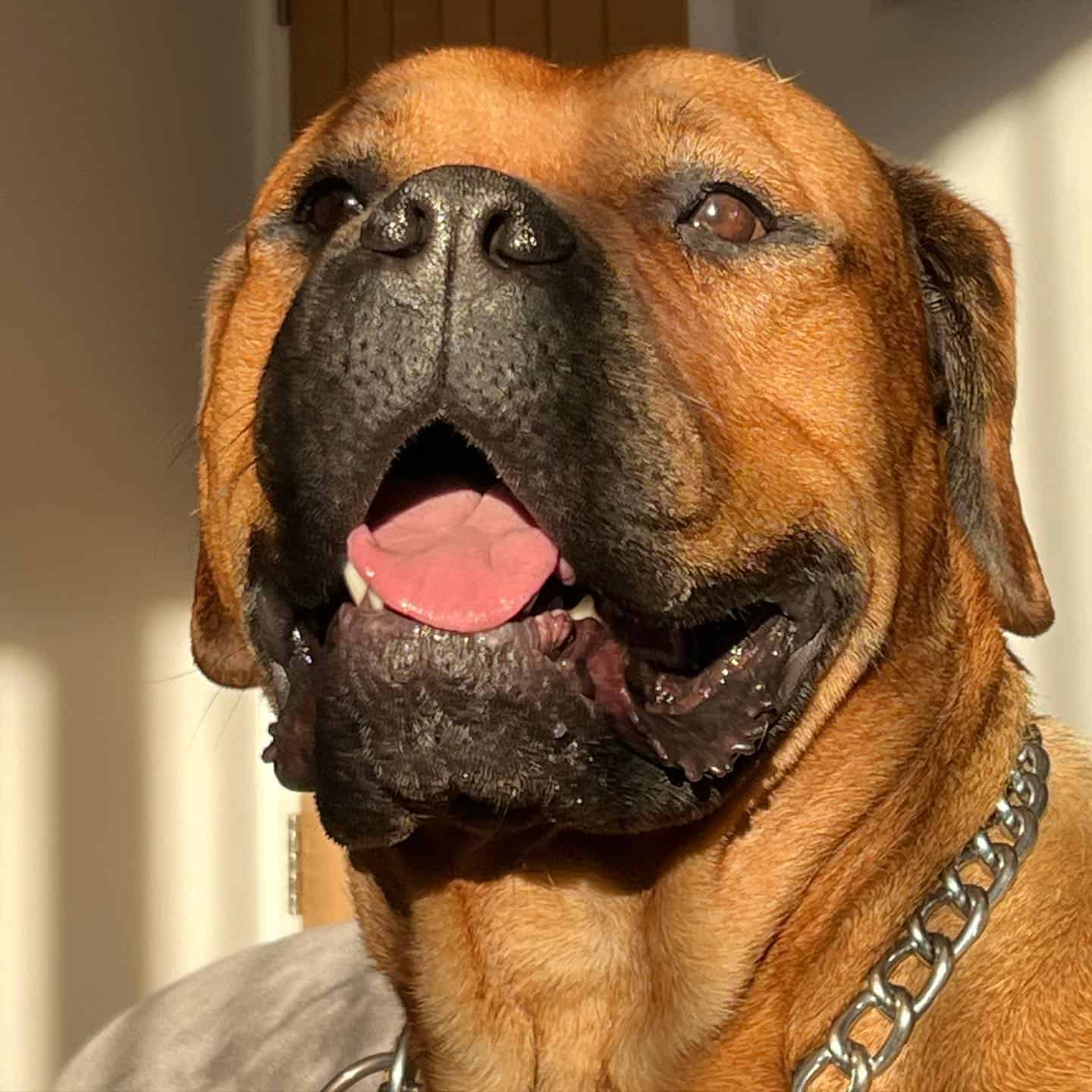
Generally, these pooches live between 8 and 10 years. This is not an impressive lifespan if we take into consideration that some large hybrids live up to 12 or 13 years. Still, this is not a surprise as its Bullmastiff and Rottie parents live up to 9 years.
In order to keep your dog healthy, you need to take into consideration its daily exercise needs and its feeding chart as well.
Both of the Bull Mastweiler’s parents need a well-organized feeding chart as they have a tendency to gain weight. This especially related to Rotties, which is why the Rottie’s feeding chart needs careful consideration!
Properly-socialized and trained Rotties, as well as Rottie mixes, make fine family dogs. Still, you should know that none of these canines qualify among the best family dogs in the world by default.
Their good manners and decent behavior is a result of hard work, obedience training, and early socialization.
However, depending on the mix, some pooches can display stubborn and mischievous behavior, such as Rottskies.
Unfortunately, the Rottweiler Bullmastiff mix doesn’t do well with other dogs as these canines like having the entire house for themselves. Furthermore, this pooch has a high prey drive, which is why it is probably not a good idea to have a small pet next to your Bull Mastweiler.
These are the traits inherited from Rottie puppies mostly, as Rottweilers can display occasional aggression.
Still, properly-socialized puppies have a good chance of becoming friends with other dogs, especially if you socialize them from an early age.
Conclusion
The Rottweiler Bullmastiff mix is the perfect companion for those dog lovers who prefer hybrid dogs over purebred ones. Hopefully, this article has given all the pros and cons related to this powerful pooch, and has also given you some hints regarding future pawrenting.
However, before buying this puppy, you should do some research yourself as there is a plethora of scammers on the market who will try to sell you an unreliable dog.
These puppies are true protectors and guardians, but at the same time, they are loyal, affectionate, and kind to their owner.
Still, they require patience and attention. If you’re way too busy to be with your puppy for an appropriate amount of time, then try considering a more easy-going breed.
Read more: Is The Rottweiler Dachshund Mix A Reliable Family Pet?
